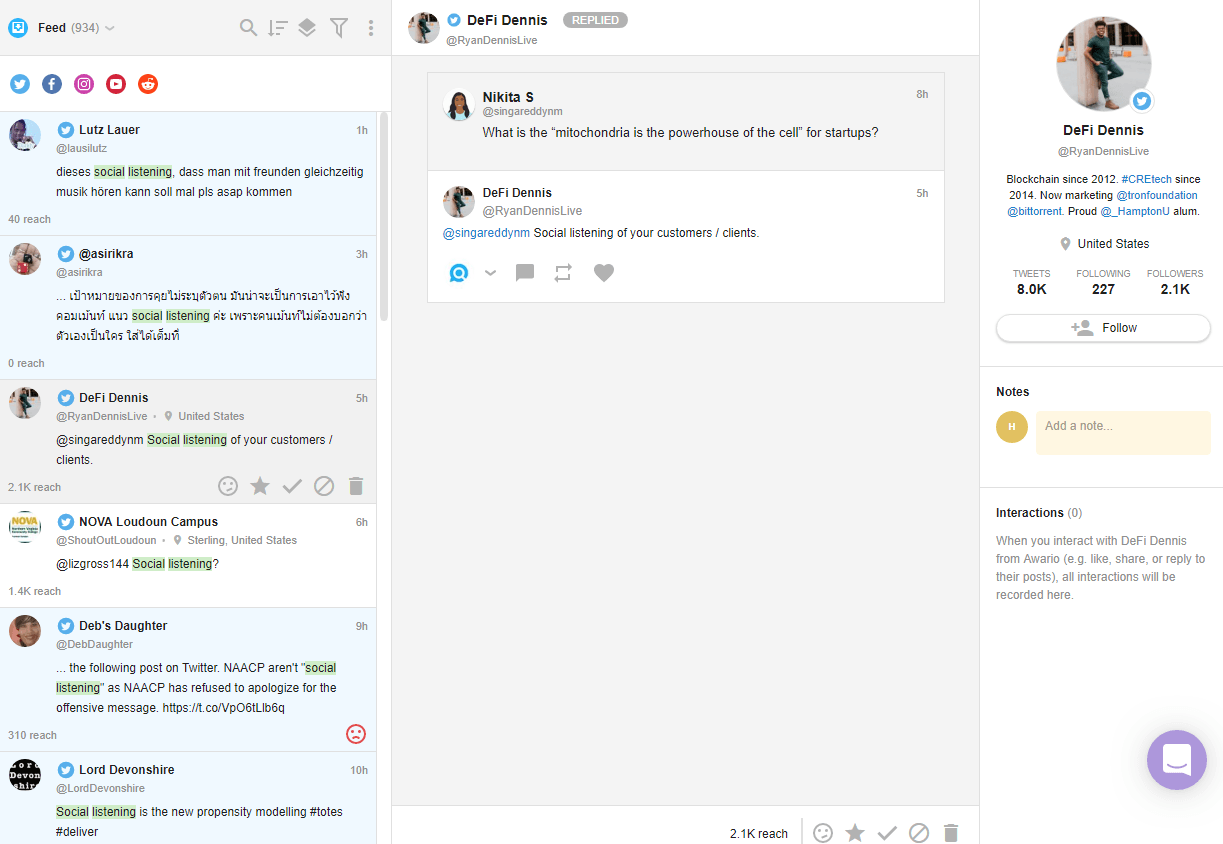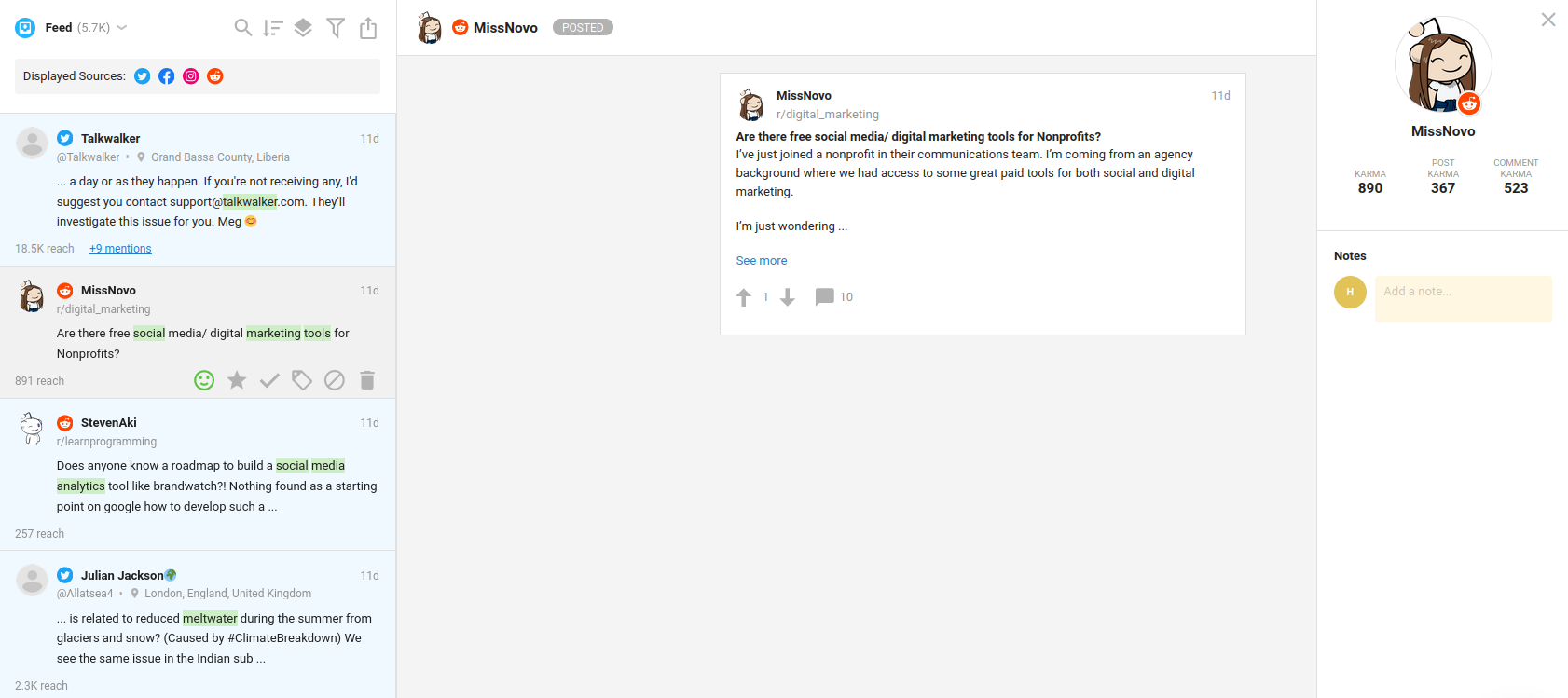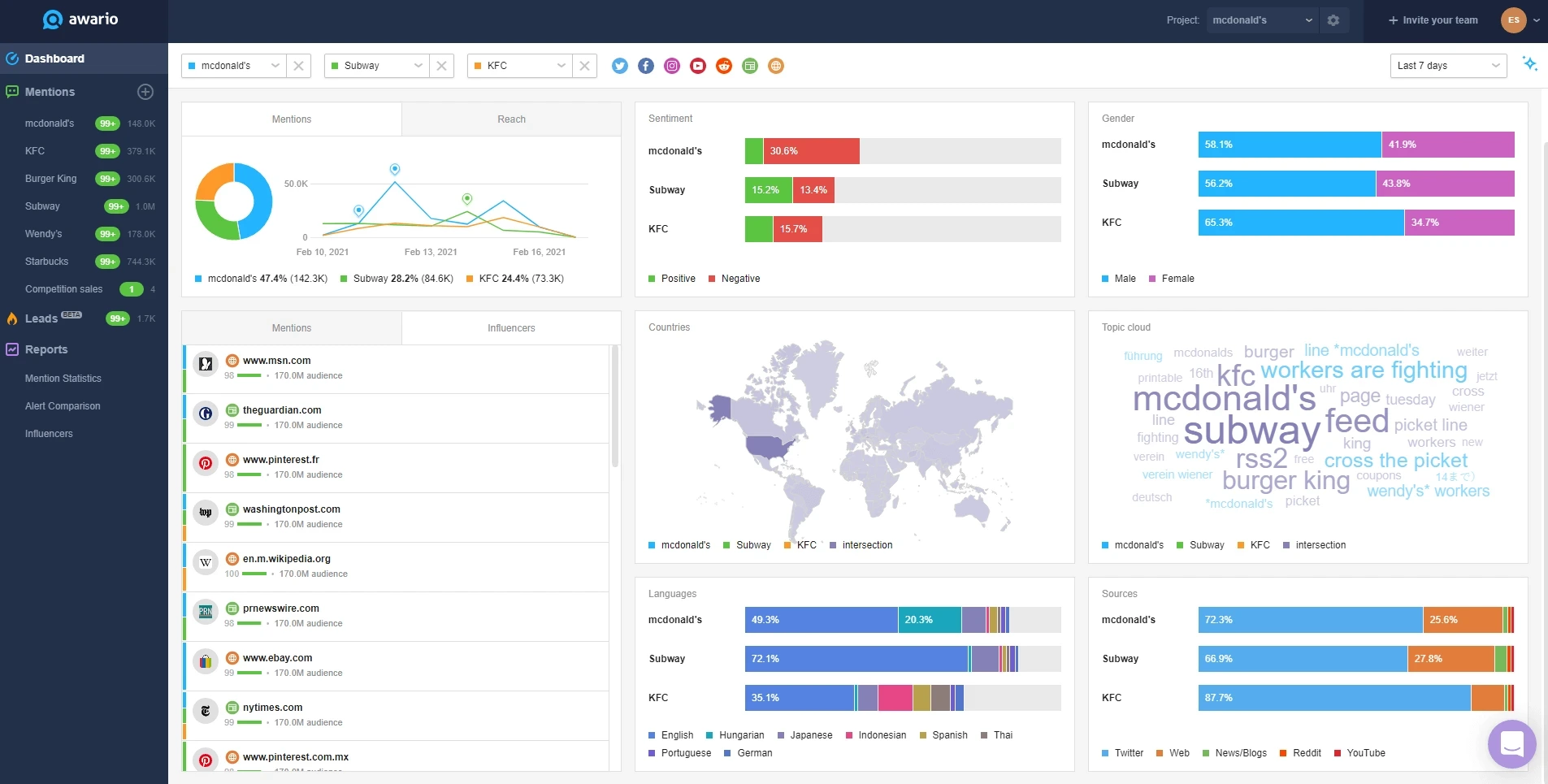Social media monitoring vs. social listening (and what's the difference between them)

Article summary
In this article, we explain the difference between social media monitoring and social listening and figure out which of these your business needs.
15 minute read
Once we get passed the question "What is social listening?" there are many more to come. One of them is "How do monitoring and social listening compare?". And it's actually a great conversation to have with your marketing team that can lead to a deeper understanding of marketing.
While both social listening and monitoring collect online mentions of your keywords, they are different. Social media monitoring describes the process of searching for, collecting, and interacting with individual mentions, meanwhile, social listening focuses not on individual mentions, but large sets of online data and and analyses information for strategic insights.
Social media marketing, just like any other industry, operates in both more straightforward and more complex terms, and this social listening vs monitoring business is not exempt from that.
For example, ‘authentic content’ is a term that is easy to understand (and also an important caveat in millennial marketing) — it is what it says on the tin. But not every marketing concept is as clear. This is especially relevant when we talk about social listening vs social media monitoring.
What’s the difference between social media listening and social media monitoring (and why does it matter)?
There’s a huge difference between social media monitoring and social listening, despite everyone and their mother using these two popular terms interchangeably. Both these terms apply to the act of interacting with publicly available social media posts and meta-information you get from them for your company's benefit. However, the similarities end there.
If we dig deeper into the issues of social listening vs monitoring, the difference between these two is extremely visible. It's seen in the goals you set, the approach you choose, the scale, the tools you use, and the complexity of the social listening process. Here's a convenient table of all the differences:
|
Social media monitoring |
Social listening |
| Goal - conversion | Diverse goals |
|
Customer interaction |
Data analysis |
|
Micro |
Macro |
|
Reactive |
Proactive |
|
Possible without tools |
Requires tools |
Let's go through these qualities one by one to fully understand the core distinctions between social listening and monitoring.
Scale: Micro vs. Macro
Social monitoring is happening at the micro-level: your team sees a customer's mention and depending on its content, either you thank them for a positive review or address their problem and try to help just like any other customer care team would.
Obviously, this interaction may lead to more: another user might get involved, and your customer might contact you later with questions or requests, but in its nature, it's a short-term personal interaction.
Social listening works on a much bigger scale. While with monitoring you observe, collect, and get involved in individual conversations, social listening (or social analytics) considers how your company, your products, your representatives, competitors, and markets are discussed on the whole.
As opposed to interacting with separate conversations, you interact with large amounts of social data and analyze it to gain valuable insights into customers' perceptions of your company, competitors, social events, and so on. Social listening is able to identify social trends and highlight your brand's strengths and weak spots.
There's a common saying in the marketing world (yes we do have our own sayings) that goes like "social monitoring is the trees; social listening is the forest".
By signing up I agree to the Terms of Use and Privacy Policy
Business goals: Specific vs. Diverse
The business goals that are accomplished by social media monitoring boil down to two business processes related to social media: social customer care and social selling. You track your online mentions to catch the posts of existing or potential customers on various social media channels and connect with them.
Thus, social media monitoring is a great tool for your sales and customer support team or teams.
Both include direct interactions with people and both aim to help and please either existing or potential customers. Basically, you can set two business goals to benchmark your monitoring efforts: customer satisfaction and conversions.
What's unique about social listening is that its possible applications are extremely diverse.
You can set all kinds of business goals for your social media listening strategy: raising brand awareness, modifying your product based on the competitors' strategies, and carrying out a successful marketing campaign that corresponds with your target audience's values.
Social listening is truly a multi-purpose and versatile approach to online data analysis that can influence your company's future decisions.
Approach: Reactive vs. Proactive
Many articles about social media monitoring start with the same scary story of an unhappy customer starting an online conversation about a brand and being completely ignored by the company.
Or, sometimes, a happy story, where a customer sees a brand responding to the posts on their channel in no time and noticed their excellent social support and active online engagement. Customers are happy and the social media team's careers are saved!
While both these stories have completely different outcomes, they have something in common - they illustrate the reactive approach to social media. Or rather, social monitoring is reactive on principle.
The principle of the reactive approach lies in, surprise surprise, reaction, meaning you need an instigating message to react or respond to. When we are talking about social media monitoring, engagement is not possible without a user initiating it.
Even the process of social selling (when you use monitoring to find potential customers) requires a post from a user indicating their interest in a certain product to respond to.
Obviously, the reactive approach is extremely important, I don't think I need to tell you about the dangers of ignoring your customers.
However, just like in life, listening is proactive. What social listening allows you to do is to gather all these individual posts from people, see the bigger picture, and act on it changing your marketing and social media strategy. It's able to provide insights that can have long-running consequences for your brand in the future.
For example, social monitoring may enable you to help a customer with a pair of speakers not working properly, and social listening allows you to notice that the highest number of mentions you get is about wireless speakers, and make a conclusion that those are pretty popular.
Moreover, the social listening data you analyze doesn't have to be based on your mentions. You can get tons of valuable insights by listening to conversations about your competitors, your customer's needs, recent events in your industry, and so on. It gives you a wide view of the market you exist in and the circumstances around it. With social listening, you can find reviews on Instagram and vlogs on YouTube about your product. You can reshare Instagram posts or use legal methods to download youtube video to mac, then repurpose them by creating summaries or highlights for your social media content strategy.
Social media listening fuels new ideas and shows you the course of actions you need to take to improve your businesses — that's why social listening is proactive.
Tools: Manual vs. Automatic
Social media monitoring is not a new concept. Even if you haven't heard the term before, you are probably already doing it on a regular basis: you probably check your notifications and direct messages daily to see if anyone has reached out. This is social media management 101 and can be done manually, meaning, you don't need any special tools to find and respond to these mentions.
Native search capabilities of the social media platforms even enable you to look for misspellings and untagged mentions of your company to make sure you don't miss a single customer trying to communicate.
I'm not saying that you don't need a social media monitoring tool at all. With a tool you can:
- get notified every time someone mentions your company,
- sort mentions chronologically,
- see negative mentions first,
- group mentions simplifying your workflow.
Besides, study after study shows that response time is extremely important when it comes to engaging with customers — people expect you to answer in an hour. And, of course, if you get more than just a couple of mentions a day, a tool becomes essential — you just won't be able to deal with the influx of customers' posts without it.
Social listening, on the other hand, is impossible without a social listening tool. You simply cannot uncover large amounts of social listening data and analyze it manually. According to research done by Forrester, 52% of social listening tool users considered social data analysis their top challenge. Moreover, paid tools allow you to collect and analyze social data that is not directly related to your company, which proves to be vital for marketing research.
You can't see patterns and trends just by looking at raw social listening data. The true power of social listening lies in analysis and visualization, which is done by a social listening tool.
For example, the standalone number of mentions you get every day won't tell you much, but if you look at the graph depicting the overall change in the number of mentions during the last quarter, the changes in your brand awareness level will be visible immediately.
A social listening tool is what makes the meaning behind numbers visible.
Trying to do social listening without a tool is like trying to fish without a rod. You'll get swamped in useless Excel sheets doing that without getting any social listening insight.
Luckily, they are not some kind of luxury — there are a lot of social media listening tools on the market you can look into, you don't need to be the richest of CMOs to afford them.
By signing up I agree to the Terms of Use and Privacy Policy
I drafted this 'social monitoring vs social listening' dichotomy to illustrate their differences clearly, but the thing is, you can and should do both simultaneously AND with just one tool.
Some tools that work with social mentions emphasize either monitoring or listening in their functionality, but the best of them offer features that enable you to do both at the same time.
So let's use Awario as an example and figure out how you can use a tool for social media monitoring AND listening. Here's how to monitor social media with Awario.
Social media monitoring workflow
Needless to say, the first step for both monitoring and listening should be the alert set up. An alert may contain several keywords and keyword combinations as well as some conditions: for example, if you want to find mentions from a specific country or certain social media channels.
For monitoring, you're probably going to set up an alert for your brand name. Don't forget to include abbreviations, misspellings, and your social media handles.
Your focus should be on Awario's feed.

Awario automatically sorts conversations in chronological order so you can address the latest right away, but you can also select to sort them by Reach (those which were seen by the most people come first) or a number of mentions (those that have the most replies or comments come first). You can also filter the feed to show you only negative or positive mentions, mentions from a certain period of time, from a certain source and so on. You can get involved in these conversations right from the dashboard. Awario will save all your interactions with a user and show them each time you come across their posts.
By signing up I agree to the Terms of Use and Privacy Policy
Another way to use social media monitoring is lead generation. Awario has a module titled Awario Leads, where you can create a separate alert for social posts indicating a customer's interest in your type of product.

You can mark mentions as done, delete them, or block users from appearing in your feed altogether. All this may prove useful for working in teams.
Social listening workflow
The first step is pretty similar: you need to create an alert. As I mentioned above, you can utilize social media listening in many different ways and they all come down to keywords you'll choose to monitor. Your alert can contain:
- your company name,
- names of your products,
- your marketing campaign name and associated hashtags,
- your competitors,
- niche-related terms,
- a relevant event,
- anything else your imagination and business needs may produce.
Once you set up the alert, you can see initial data analysis by going to the Dashboard.

The Dashboard displays demographic and user-behavior insights: how many people saw your keywords, where they are, what languages they speak, what words they use alongside your keywords. You can go to Mentions Statistics to get a more comprehensive look at this data. You can also compare several alerts, for example, juxtapose your data with your competitors.
Awario also enables you to find influencers by analyzing the most influential voices who mentioned your keywords. They are rated based on the number of followers and reach they have and presented in a list.

Since Awario gives you access to historical data, you can notice developments and trends right away.
In conclusion, the question of social monitoring vs. social listening is an important one to consider, but it's not an either-or question. Both should be a part of your social media strategy and both are easily done with Awario.
In the end, it doesn't matter if you're always using social media monitoring definition and social media listening definition correctly, what matters is you understand how to use the tools you have to get all the utility they can offer.
F.A.Q
What's the difference between social listening and social media monitoring?
Social listening is a broader strategy that includes monitoring. Social media monitoring refers to the process of gathering mentions of your keywords and interacting with them. Social listening analyzes gathered mentions for valuable customer and industry insights. By considering social media monitoring vs. social media listening you can appreciate different purposes they serve.
What can brands use social media monitoring for?
Social media monitoring helps you find and interact with the mentions of your brand. You can use it for community management, social media customer support, and social selling.
What can you use social listening for?
Social listening allows you to analyze large numbers of mentions to get customer and industry insights. You can see where your or your competitors' customers are based, what social media platform they use, how they feel about your product, and more.
What tools can you use for social media monitoring and social listening?
To kill two birds with one stone, you can use a social listening tool both for monitoring and listening. Any company can find something that fits their goals and budget: there are affordable but powerful listening tools such as Awario and Enterprise level data powerhouses such as Brandwatch or Sprinkle.













